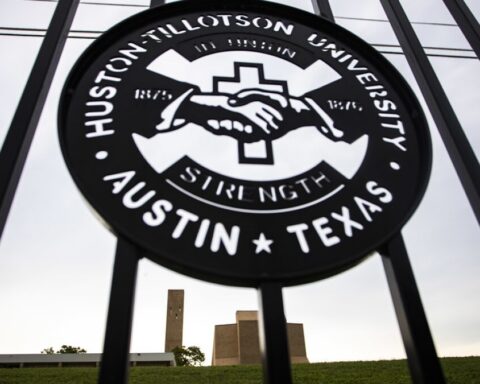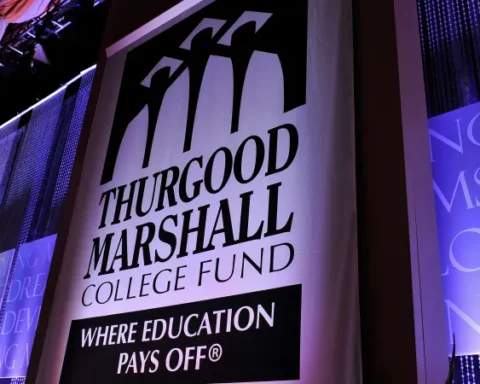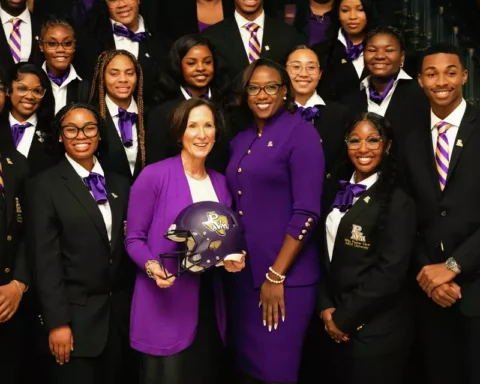By Amber Burton
As a business major at Prairie View A&M University in Prairie View, Texas, Sean Johnson had been on track to work in finance after graduating. But then his adviser mentioned a program that the historically Black university had with Accenture and Microsoft that was meant to function as a direct pipeline from Prairie View into roles in tech. It changed his entire career course.
Johnson had always had an interest in tech, and the prospect of being able to get a glimpse into the industry, as well as gain real, hands-on experience, appealed to him. By the end of the program, he had a full-time job offer at Accenture.
Accenture has had a relationship with Prairie View A&M for over 30 years, but two years ago, the tech company decided it was time to step up its involvement, said Atieno Obala, a managing director in Accenture’s Houston office. Known as Level Up, the partnership program focuses on recruiting and mentoring students seeking roles in tech. Obala also serves as the program lead.
Level Up is keenly focused on targeting the underrepresentation of minorities in the field of technology and innovation with hopes to scale and be replicated by other tech companies and in other cities across the U.S. Level Up’s first cohort had five students; all received offers for full-time employment or an internship at the end of the program.
But even with effective programs like these, a job market that still remains hot and numerous companies’ claims that they want to increase their diversity numbers, representation at tech companies of Black and Latinx workers has remained low over the past several years, and Big Tech is still overwhelmingly white.
While many U.S. tech companies have made progress in gender representation, racial representation in technical roles has been fairly stagnant, leaving some to believe that the so-called talent “pipeline problem” is instead a locked door preventing many skilled and proficient college graduates from ever stepping foot in the interview room.
Black technical workers are still underrepresented at Big Tech companies
Last year, the Pew Research Center found that Black workers make up 11% of all employed adults in the U.S., compared with 9% of those in STEM occupations. And the fraction is even smaller in some STEM roles, including just 5% in engineering. Pew also found no change in the share of Black workers in STEM jobs since 2016.
The numbers at HBCUs are different.
10% of all Black computer science majors with conferred degrees in 2020 graduated from an HBCU, though the schools only account for about 3% of higher education institutions, according to a recent report from the Kapor Center. But while HBCUs may be churning out a substantial number of computer science graduates and potential tech workers despite their size, there was only a 1% increase in representation of Black workers in technical roles at large tech companies between 2014 and 2021.
Recognizing the gap in talent, some tech companies have begun working to go beyond more passive recruiting efforts to partner with HBCUs and boost the number of students they hire from the schools, but many still have a long way to go.
Where current HBCU recruitment efforts go wrong
“In terms of Black representation in computer science at the higher-education level, we don’t see as great a disparity as we see in the workforce,” said Ivory Toldson, the director of Education Innovation and Research at the NAACP.
Toldson explained the issue like a glacier: Tech recruiters frequently court computer science graduates from the top schools they can easily see or identify, but the further outside the list they go, the less frequently they recruit. A smaller percentage of Black computer science graduates go through the top universities that many tech companies flock to when recruiting talent. But a larger group of Black computer science students graduate from HBCUs, and an even larger number of them come from small regional state universities, two-year institutions and technical training institutions where recruiters tend to be less proactive about recruiting. As you get away from the most-commonly referred schools among tech executives, you get a more diverse population to draw upon, Toldson said.
“I think if we’re going to really diversify the pipeline, we need to have an honest conversation about how to get institutions in the game that we are shutting out … and we need to be honest about the ceiling we are placing on them,” he said.
Toldson acknowleged that many tech companies aren’t exactly new to this conversation. In fact, quite a few tech companies have been forming relationships with HBCUs over the past 10 years, he said.
So why aren’t all of these initiatives translating into corporate representation numbers? Toldson suggested that Big Tech is thinking too small, and said that many partnerships are run by program leaders who are not always involved with day-to-day hiring. A company might have an initiative or a partnership with an impact of 100 students, but when it comes to the thousands of applications that flood into a company every day, it’s not clear if Black and underrepresented candidates are having the same level of success. If companies aren’t intentional, there can be a real disconnect between the people spearheading partnership programs and the actual hiring managers interviewing and selecting candidates for jobs.
Rich Cho, chief recruiting officer at talent acquisition platform Gem, said that many diversity recruitment strategies are also unintentionally tied to a school’s efforts to diversify its student population — meaning, if some of these top schools are struggling to diversify their student body or increase their own number of Black students, then the companies recruiting there will also inevitably have a hard time hiring more diverse candidates because they’re relying on the schools for sourcing talent.
“This is why it is important to rethink the university recruiting strategy and increase the mix of HBCUs, HSIs and other institutions that have a higher representation of underrepresented minorities. Meet the talent where they are at, and not the other way around,” he told Protocol in an email. Cho said that Gem is planning to experiment with blind technical assessment tools to assist with hiring, where pedigree is not a factor (and the assessment is simply based on a candidate’s skills), as well as using its own DEI analytics tool to see how diverse candidates move through the recruiting funnel.
Efforts to close the talent gap
Some experts believe the gap will only be filled by companies that are willing to do more of the “deep work” to develop a more effective talent pipeline. For Allison Scott, CEO of the Kapor Center, that means companies helping to sustain and support the institutions that are producing some of the top Black talent beyond surface-level initiatives.
“HBCUs have a significant track record of success as it relates to STEM graduates overall, but specifically computer science graduates, and they are punching way above that weight in the production of Black CS graduates. But if you think about the resources that a university needs to sustain itself … under-investment in HBCUs I think hinders the ability to produce even more,” she said. “So they’re producing a substantial proportion, but that number is still actually pretty small.”
Scott believes these schools show signs they could feed even more students into the industry if given more resources; she pointed to Netflix CEO Reed Hastings and his wife Patty Quillin as an example of what more can be done by influential executives. They made headlines earlier this year when they donated $10 million to fund scholarships at Tougaloo College, an HBCU, as well as Brown University. Half of the money was earmarked to go to Tougaloo College, and the other half was set aside for a partnership between Brown and Tougaloo in recognition that “HBCUs have been vastly undervalued for a long time,” Hastings said in a statement. (The funding is not just for students seeking to go into tech.) Netflix did not immediately respond to a request for comment.
As a response to the call for more deep work to be done, some companies have developed more partnerships with HBCUs on the ground; however, many are still small in scale. Last year, Amazon Web Services announced it would partner with Howard University to create a master’s degree program focused on data science as well as cloud concepts.
Apple also has several partnerships and programs with HBCUs, including its New Silicon Initiative and HBCU C2. The New Silicon Initiative involves grants to support HBCU engineering programs, specifically related to hardware engineering and silicon design, while HBCU C2 is a partnership with Tennessee State University that brings coding and creative experiences to the HBCU community through its own hardware and curriculum. Apple also has a scholarship program with the Thurgood Marshall College Fund, which provides merit-based scholarships as well as an internship at the company.
But perhaps one of the greatest challenges to some of the partnerships in the industry has been the companies’ own culture. Last year, after Google fired its leading AI ethics researcher Timnit Gebru and a number of alleged instances of racial discrimination arose, five HBCU leaders met with Sundar Pichai. Many of the leaders wanted to know more about the atmosphere they were sending their students to work in to ensure they were being recruited into an environment where they could actually thrive.
In the months since, Google has continued to face allegations of harassment and discrimination. In March, a former Google recruiter who helped establish a pipeline for young Black technical talent sued the company for allegedly underpaying and under-promoting its Black employees. Google did not respond to a request for comment.
Identifying the deep work in partnerships
Obala told Protocol that the co-op program that Accenture launched last year in partnership with Microsoft and Prairie View A&M University has already seen some success.
She said leaders who wish to launch similar partnerships should start by connecting with a university’s president.
“[Prairie View A&M] is one of our top diverse schools that we source from, and we wanted to have the conversation around how we could increase our visibility on the campus, but at the same time, do more of a partnership that’s above and beyond what we normally have been doing,” said Obala. “Just having that top-down kind of leadership involved, that’s what’s so important.”
Obala said that to solve this problem, companies need to look beyond recruiting. “Make sure that you have academic affairs involved, you have financial aid involved — just having the whole university structure kind of part of your team,” she said.
Obala and her team met with the university’s president to discuss what a deeper partnership would look like. What they came up with after the conversation was a four-month co-op in which students would learn and work as full-time employees at Accenture. Students are given training and project experience, and they complete a capstone project. They are also given mentors and alumni partners to guide them through their experience, as well as access to a full suite of Accenture’s benefits, including medical insurance, a 401(k) match and the ability to join any of the company’s ERGs. But what leadership at Accenture and Microsoft touts as the largest benefit is meeting students where they are: Houston.
Like many other tech companies, Accenture is focused on location as one of its levers to access a more diverse talent pool outside of the traditional tech hubs. And though Toldson doesn’t think location is the only thing hindering Black students from getting into the workforce — in fact, it might not even be in the top five reasons — he believes proximity could help.
Microsoft also partnered with Accenture to provide training around some of their technologies and mentorship, as well as an additional office space in Houston where students can work.
Through the program, Johnson worked as a project manager, but also learned technical skills like how to code and scan databases. This summer, he will start his full-time role as a consulting development analyst at Accenture. He now sees himself as potentially working at Accenture long term and working his way up to managing director.
“I think if you’re given that opportunity, any HBCU student, I think you should not let this pass by, because this is something that you will look down the line and be like, ‘Wow, that really changed my life.’ And I really believe that it changed my life for the better,” said Johnson.





